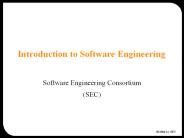SOFT COMPUTING METHODOLOGY APPLIED TO TIME SERIES ANALYSIS - PowerPoint PPT Presentation
1 / 32
Title:
SOFT COMPUTING METHODOLOGY APPLIED TO TIME SERIES ANALYSIS
Description:
Evaluate the capacity of fuzzy inference systems and classic methodologies from ... equation considering wages as an exogenous variable, focusing on demand factors ... – PowerPoint PPT presentation
Number of Views:66
Avg rating:3.0/5.0
Title: SOFT COMPUTING METHODOLOGY APPLIED TO TIME SERIES ANALYSIS
1
SOFT COMPUTING METHODOLOGY APPLIED TO TIME SERIES
ANALYSIS
- Barbara Diaz
- Visiting Scholar, BISC Program, UC. Berkeley
- Socio-economical Analysis Methods (MAS fuzzy)
- University of Malaga, Spain
BISC Seminar, October 12
2
Outline
- Objective, data and methodology
- Results in a classical approach
- Neuro-fuzzy approach
- Feature selection
- Input space partition
- Fuzzy inference system
- Parameter optimization
- Results
- Conclusions and further research activities
3
FIS applied to wage employment in Spain. Study
and prediction.
- OBJECTIVE
- Evaluate the capacity of fuzzy inference systems
and classic methodologies from two points of
view - Prediction
- Conceptual interpretation of economic theory
- DATA
- Data is quarterly based (22 years data)
- The information sources are
- Active Population Survey (EPA)
- Industry and Services Salary Survey (ESIS)
- Quarterly National Accounting (CNT)
4
METHODOLOGY
- Classic time series model. AR(I)MA
- Fuzzy Inference System with Takagi-Sugeno Kang
first order rules. ANFIS. - The predictions are compared over the last five
quarterly periods
5
PREDICTION OF WAGE EMPLOYMENT IN SPAIN
- Labor demand Modelled by a single equation
considering wages as an exogenous variable,
focusing on demand factors - The labor demand is a derivate demand -- an
increase in the demand of goods and services
implies an increase in labor demand - Change in the relative costs for the labor factor
is studied through the relationship between
wages and productivity
6
WAGES AND PRODUCTIVITY
- ?Productivity ??employment?
- ?Productivity ? ? salaries ? ? demand ? ?
production ? ? employment? - Salaries
- Substitution effect
- ?salaries (production unchanged) ? ? employment
- Product effect (supply)
- ?salaries ? ? employment ? ? production ? ?
employment - Product effect (demand)
- ? salaries ? ? demand ? ? production ? ?
employment
7
VARIABLES
- Private, non-agricultural wage earners (asan)
- Private, non-agricultural gross added value
(VABnap) - Wages (sal)
- Productivity In place of marginal productivity,
mean productivity is calculated as output divided
by employed people. To improve the approximation
of productivity for full employment, the maximum
historical occupation productivity is used
8
PRODUCTIVITY (pr)
VARIABLES
WAGE EARNERS (asan)
GROSS ADDED VALUE(VABnap)
Source Encuesta de Población Activa. INE
Source Contabilidad Nacional Trimestral. INE
WAGES (sal)
Source Contabilidad Nacional Trimestral,
Encuesta de Población Activa.INE
Source Encuesta de salarios de la industria y
los servicios. INE
9
TRANSFORMATIONS
- For variables asan and VABnap the basic growth
series is used
- The unitary costs are
10
Wage earners growth rate ASANGross added value
growth rate VABNAPUnitary labor costs SUP
11
VARIABLES RELATIONSHIP
12
REGRESSION (I)
- Vt was generated by an ARMA(p,q) model
- Lagged variables werent significant for SUP
- VABNAPt-1 is significant, but we lost
significance in the other variables, hence there
was no improvement - A variable t was introduced but was not found to
be statistically significant
13
REGRESSION ADJUSTMENT (II)
- Breusch-Godfrey test, and the correlograms
observation gave as a result a model for the
residuals with AR(1) MA(4) - This improved the adjustment, but it didnt reach
the predictions results in FIS - The Theil inequality coefficient is 0.130063.
Different kind of errors BIAS, 78, Variance,
0.58, covariance (random), 20
14
FUZZY INFERENCE SYSTEM (Methodology)
Input Variable Selection
RC/SRC
Input Space Partition
Subtractive Clustering
Fuzzy Inference System (F.I.S.)
Parameters Optimization
ANFIS
Application to Prediction
15
INPUT SELECTION. RC method.Sugeno Yasukawa
(1993)
16
INPUT SELECTION.SRC methodTanka, Sano Watanabe
(1995)
2n-1 n(n1)/2
17
INPUT VARIABLE SELECTION
Y ASAN x1 VABNAP x2 SUP x3 t
SRC algorithm
18
INPUT SPACE PARTITION (Subtractive clustering)
Chiu (1994)
ra
c1
rb
19
INPUT SPACE PARTITION
Subtractive clustering
20
Initial membership functions
21
FUZZY INFERENCE SYSTEM (F.I.S.) Takagi-Sugeno-Kang
if x is A and y is B then zpxqy
22
PARAMETER OPTIMIZATION (ANFIS) Jang (1993)
23
PARAMETER OPTIMIZATION (ANFIS) Jang (1993).
Hybrid learning algorithm
Least squares
Error back propagation
24
Optimized fuzzy membership functions
25
FUZZY RULES
26
VARIABLE RELATIONSHIPS (F.I.S.)
27
F.I.S. RESULTS
28
COMPARISON TO REGRESSION
29
COMPARISON BETWEEN PREDICTIONS
30
COMPARISON BETWEEN PREDICTIONS (II)
- Theil inequality coefficient in FIS is 0.046426,
Different kind of errors BIAS, 9.3, Variance,
19.8, covariance (random), 70.8 - Theil inequality coefficient in regression is
0.130063. Different kind of errors BIAS, 78,
Variance, 0.58, covariance (random), 20
31
COMPARISON BETWEEN SYSTEM ADJUSTMENTS
32
Conclusions and further research activities
- Good approximation and prediction results
- Good to model non linear relationships
- Risk of overfitting
- Possible Improvements
- feature selection
- Prediction intervals
- Other approaches
- Mamdani fuzzy rules and supervised competitive
learning techniques. (confidence intervals
defuzzification methods. (Dusan Marcek, 2004) - Qualitative description of time series based on
moving approximations.(Batyrshin et al, 2004). - Fuzzy clustering of short time series (2003).
- Support vector regression applied to time series
analysis..































